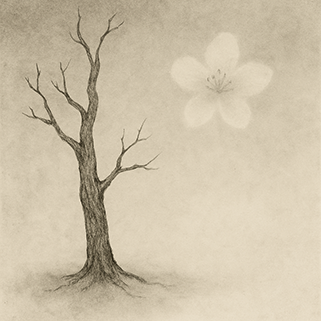Xieyi・The Rootless Tree:24 Chapters-Chapter 24#528

The poems of “The Rootless Tree” express a fundamental force rooted in harmony with heaven and earth, the cyclical flow of yin and yang, and the infinite potential of existence。
This painting is an expressive “Xieyi” in the tradition of “futu” (spiritual diagrams), passed down for generations in Wudang Mountain, China. It is drawn through a technique where energy flow (xingqi) channels the internal intention into visual form。 In the Taoist world, there exist spiritual and symbolic images called “futu”。
In the Taoist world, there exist spiritual and symbolic images called “futu”。
These are a type of talisman—not merely religious items, but expressive spiritual paintings that act directly on the mind of the viewer。
Since ancient times, many people have placed these Taoist-style “Xieyi” and futu in their homes, studies, or bedrooms, wishing for longevity, health, auspiciousness, and family harmony. Viewing such paintings was not just aesthetic appreciation, but an act of inviting the presence of the Dao into one’s life and tuning the body and mind。
Thus, “Xieyi” is more than artistic expression—it is a medium that bridges the spirit, life, and harmony with the universe。
This kind of artwork is not meant to be seen only with the eyes, but felt with the heart。
It communicates with the Dao, resonates with the qi of nature, and quietly stirs the viewer’s inner self。
Futu and “Xieyi” continue to live on from ancient times to this day as “sacred images that speak to the soul.”
Below, we present the original text of the philosophical poem “The Rootless Tree,” along with a modern Japanese translation and interpretation。
※ The author of “The Rootless Tree,” Zhang Sanfeng (1247–?), is also renowned as the founder of Tai Chi, and it is said that he applied the essence of this work to Tai Chi. As an additional note, we include an interpretation connecting this to the Tai Chi tradition of Wudang Mountain.
The Rootless Tree・Chapter 24

▶Original Text
無根樹,花正無,無影無形難畫圖。無名姓,卻聽呼,擒入中間造化爐。運起周天三昧火,煅煉眞空返太無。謁仙都,受天符,纔是男兒大丈夫。
▶Modern Translation
The flower of the rootless tree is “nothingness” itself—no shadow, no form, unpaintable.
Without name or surname, yet it responds when called.
Capture it, place it in the alchemical furnace.
Ignite the fire of the celestial cycle, refine true emptiness, and return to Grand Nothingness.
Join the Immortal Capital and receive Heaven’s seal—this is the path of the true man.
▶Interpretation
• Describes returning to Wuji—the primordial void.
• “Heaven’s seal” symbolizes spiritual completion and cosmic authority.
▶Interpretation related to Tai Chi
Tai Chi’s highest realm is return to Wuji—motion arising from stillness, form dissolving into essence.
This chapter marks the final transformation: beyond skill, into true being.
Copyright © MASAKI WAKABAYASHI. All rights reserved.




